
8 Days Lhasa to Kathmandu Overland Tour via Mount Everest Base Camp

Tour Overview
This 8 days Lhasa to Kathmandu Overland Tour via Mount Everest Base Camp is a wonderful and attractive Tibet tour, including snow-capped mountains, huge glaciers, sacred lakes and other natural...
Code of Tour: YCT0000010241
Length of Travel: 8 Day
Destinations of Tour: Lhasa / Gyantse / Shigatse / Mount Everest / Gyirong / Kathmandu
Departure City: Lhasa
Price of Tour: Request
Type of Tour:
Features of Tour: Photo Nature Culture History Minority
Detailed Itinerary
Day 1 Lhasa Arrival
Welcome to the roof of the world! You will be picked up by local tour guide at the airport hall or train station, then be escorted to your hotel in Lhasa city in a private vehicle.
After arrival at your hotel, the rest of the day is free for you to explore the local areas and acclimatize yourself to the air, temperature and high altitude of Lhasa.
High Altitude Acclimation Tips:1) go for some leisure walking to acclimate the high altitude but avoid strenuous activity after arrival; 2) you’d better not have bath, in case of catching a cold; 3) drink more water, and have some fruit; 4) have a good rest…
Day 2 Lhasa ( B )
Start today’s Lhasa exploration with an exciting visit to the landmark –Potala Palace which is regarded as one of the most beautiful architectural building in the world. You will climb up the palace along the zigzag stone paths with white-and-red walls to the top of the palace where you can not only appreciate the exotic Tibetan-style architecture, but also get a great view of Lhasa’s urban areas, then walk into the inner space of Potala Palace to explore the stately chapels and learn about the history of the palace.
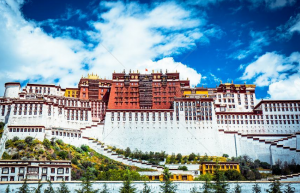
Continuing your exploration, you will then get to Jokhang Temple which is considered as the spiritual heart of Tibetan Buddhism. Each day, there are thousands of pilgrims coming from different places in Tibet to the temple to worship to the Buddha. This temple is also known as the “house of Buddha” because it keeps the precious Jowo Rinpoche, the life-sized (5 foot/1.5m) image of the Shakyamuni at the age of 12. The last site for today’s exploration is the famous Barkor Street. It is a circular and wide street encircling the Jokhang Temple. The local people like to walk on the street for several circles usually in the late afternoon as a daily tradition of pilgrimage. The street also has many shops selling a wide variety of traditional Tibetan goods, religious items and handcrafts.
Tips of today: 1) there are 1,080 steps up to climb to the top of Potala Palace, so don’t walk in a rush, which may cause high altitude sickness; 2) taking photos is not allowed inside the palace; 3) today you will be mainly outside, please bring some water, a hat, sun cream, and sun glasses with you.
Day 3 Lhasa ( B )
After breakfast, you will firstly go to visit the beautiful Norbulingka which used to be the former summer palace of Dalai Lamas in the ancient time, and now is a public park. It is famous for its Potrang, the private palaces of former Dalai lamas with grandiose Tibetan architecture style. Next, drive several kilometers to the western outskirts of Lhasa to visit Drepung Monastery. Drepung, in Tibetan, means “prosperity”. Since its establishment, Drepung Monastery has always been one of the most important Buddhist monasteries in Tibet. In its heyday, there were more than 10,000 monks lived and studied in the monastery. Throughout its history, many important and famous Tibetan leaders used to study here, especially the Dalai Lamas. So Drepung Monastery is also respectfully known as the “Mother School of Dalai Lamas”.
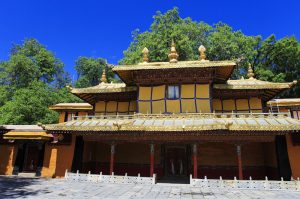
In the afternoon, you will be taken to another famous monastery in Lhasa – Sera Monastery. It is famous for the spectacular “Buddhism Debating”. As a daily routine, the monks gather in a courtyard, and debate on the Buddhist doctrines with supplemented gestures, which is thought to be helpful to facilitates better comprehension of the Buddhist philosophy to attain higher levels of study. After enjoying the “Buddhism Debating”, you will be transferred back to the city. The rest time is your own free time to rest.
The Etiquette of Visiting Monastery: 1) you shouldn’t wear short and uncover shoulders; 2) taking off your sunglasses and hat before entering the chapels; 3) taking photos is usually not allowed inside the chapels.
Day 4 Lhasa – Gyantse ( B )
Today you will leave Lhasa and drive about 6.5 hours to Gyantse. The first site you will reach is the holyYamdrok Lake. As the largest fresh lake in the northern of the Himalaya Mountains, it spreads about 675 square meters from south to north, like an eardrop lying in the arms of snow-capped giant mountains. Viewing from a distance, you can see fertile pastures full of yaks and sheep, and some small Tibetan villages along the lakeshore. Keeping driving not so far from Yamdrok Lake, you will see the imposing Karola Glacier towering aloft on the right side of the road.
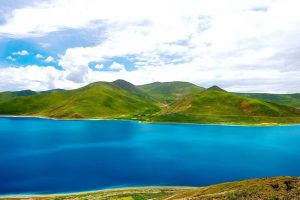
Continuing your trip, you will get to the historical city of Gyantse. Feel hungry? Have a good lunch in the town, then go to visit the mysterious Palcho Monastery. The monks and tradition of three important sects of Tibetan Buddhism – Sakyapa, Zhalupa and Gelukpa, peacefully coexist in this monastery. Its Kumbum, which is 35 meters high and has 76 small chapels with hundreds images of Kriyatantras , is believed to be the largest such structure in Tibet. Finishing the visit in Palcho, go to take some photos of the Gyantse Dzong Fortress on which the Tibetan army used to fight against the British army’s invasion during the early 20th century. It is a very impressive fortress with typical Tibetan palace architecture style which is inherited from Yumbulagang Palace – The First Palace of Tibet.(Gyantse Dzong Fortress now is closed for maintenance. Tourists cannot climb up to the top, but still can enjoy its magnificent appearance from the square at the foot of the Dzong Hill.)
Tips of today: 1) wear warm clothes to prevent from cold and wild; 2) the road condition from Lhasa to Gyantse via Yamdrok Lake is good; 3 feel free to ask your driver to stop so you can stretch your legs or take some pictures.
Day 5 Gyantse – Shigatse ( B )
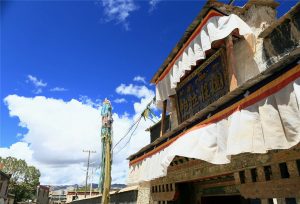
After breakfast, you will going to visit a very special site where you can learn about the living condition and tradition of old Tibet –Pala Manor. Located in a Tibetan village about 4km southwest from Gyantse city, Pala Manor is the only aristocratic manor preserved well in Tibet, and used to be the private manor of Pala families since 17th century. The aristocratic and the serfs both lived in the manor but completely different life. The aristocratic didn’t need to work, lived in bright, large and luxury rooms, used costly furnitures and imported luxuries, such as OMEGA watch, LV purse, wine, etc. While the serfs lived in dark crude room in yards, got paid little but did all the labouring works. Fortunatly, the house, relics in the rooms are still remain the same as they used to be.
After the visit in Pala Manor, drive about 2.5 hours to Shigatse. After lunch, you will take a visit to the official seat of Panchen Lama – Tashilhunpo Monastery,which is also the largest and most influential Gelug Monastery in Shigatse prefecture. Here you will see a giant statue of Future Buddha, the largest one of its kind on earth ( 26.2 meters high and 11.5 meters wide ), decorated with precious pearls, turquoises, corals and ambers.
Accommodate in Shigatse City.
Tip of today: 1) the road condition is fairly good; 2) obey Buddhist manners and talk appropriately when visiting Tashilhunpo.
Day 6 Shigatse – Mount Everest / 350km, About 7hrs’s Driving ( B )
Today, you will leave Shigatse for the final destination of your Tibet trip – Mount Everest. Though being a long driving of about 7 hours, but the views along the road are stupendous. In clear days, you can see the clear face the Himalaya range including several famous peaks over 8,000 meters, such as Makalu, Lhotse, Gyachung and Cho Oyu. When you finally get to the Rongbuk Monastery(altitude: 4,980m), and get the first sight of the mighty Everest, you will immerse in a solemn ethereal mood and find all the efforts you have made along the long way are not in vain. Located about 5100 meters above the sea level, Rongbuk Monastery is the highest monastery in the world. It is the best location to take some great photos of the front face of Mount Everest. The rest of today is free for you visit the Rongbuk Monastery and explore surrounding landscape.
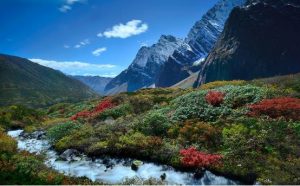
Accommodation: if you visit Mount Everest during off season (November to April), you will accommodate at Rongbuk Guest House near the Rongbuk Monastery; if you visit Mount Everest during the peak season(May to October), you will accommodate at the Tibetan Tents Camp which is about 4km further from Rongbuk Monastery. Please note that the accommodation at both places is very simple and basic, only dorm beds with communal squat toilets are available. Duvets, heated blankets and hot water will be provided, and you are suggested to bring your own sleeping bag and toilet paper. There is no running water, sinks or showers. The dining room just offer basic breakfast and dinner without menu. Remember to dress warmly all the time.
Tips of today: 1) prepare more food and drinks for long driving; 2) bring a warm and thick coat for low temperature in Everest; 3) avoid strenuous activity to prevent from high altitude sickness.
Day 7 Everest – Gyirong Town / 370km, About 8hrs’ Driving
Wake up early to enjoy the marvelous sunrise on the peak of the world. Then drive about 4km further to Tibetan Tents Camp (altitude: 4900m) where you can enjoy a closer view of Mount Everest.
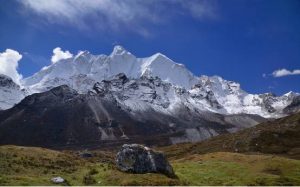
The top part of the Mount Everest is always covered by snow all the year round, and when the sun shines on the mountain, the peak is like a giant white pyramid, which is one of the most famous sceneries of Mount Everest. In bright days, you can also see a wisp of cloud hanging above the top of Mount Everest. It flies eastward in the fast western wind just like a flapping flag. This unique phenomenon is the spectacular “Cloud Flag”. The cloud will change from surging waves into a thin cooking smoke or from galloping steeds into the mysterious veil of a goddess.
Till now your Mount Everest adventure is about to end. The rest of today is to drive to Gyirong Town. The views along the road are stupendous. In clear days, you can see the clear face of Shishapangma Peak and enjoy the beautiful view of Pekutso Lake.
Accommodate at Gyirong Town.
Tips of today: 1) to protect the environment of Mount Everest, currently Everest Base Camp is not open for tourists– the Everest landscape can be enjoyed at Rongbuk Monastery and Tibetan Tent Camp as well. The base camp marker, a tablet reading “Mt. Qomolangma Base Camp” has been transferred to the Tibetan Tent Camp. You are suggested to take a photo at the marker to commemorate your wonderful adventure tour; 2) the sunrise usually starts around 6:30 am to 7am on Mount Everest; 3) keep warm all the time.
Day 8 Gyirong – Kathmandu / 185km, About 7hrs’ Driving
Today, you will leave the territory of Tibet. Drive about 25km to the Gyirong Port where you will walk across the custom to Nepal territory and transfer to Kathmandu. Though the distance is only about 160km, it takes more than 6 hours to drive to Kathmandu from Gyirong Port because the road is narrow and bumpy. During the rainy season, the road is muddy and may be closed for the landslides.
Tips of Today: Our service will end at the border of Tibet and Nepal. If you want, we can also arrange the transfer from the border to Kathmandu for you with an extra charge.
Recommended Hotels
| City | 5 Star | 4 Star | 3 Star |
|---|---|---|---|
| Lhasa | Luxury St. Regis Lhasa Resort | Lhasa Yak Hotel | Lhasa Xiongbala Hotel |
| Gyantse | / | Yeti Hotel | Gyantse Hotel |
| Shigatse | / | Shigatse Manasarovar Hotel | Shigatse Hotel |
| Rongbuk | / | / | Everest Guesthouse |
| Gyirong | / | / | Gyirong Hotel |
Service Inclusion
- Tibet Travel Permit and all other necessary permit to Tibet
- All lodging listed in the itinerary. If you travel individually, you will need to share one room with another tourist. If you prefer to stay in one room by yourself, you will have to pay the single room supplement
- Meals listed in itinerary
- Entrance fees of all tourist sites listed in the itinerary
- Local Tour Transfers according to group size
- Local Tibetan English-speaking guide
- One shared big Oxygen tank in the car
Service Exclusion
- Chinese visa
- International flight to and out of China
- Domestic train/flight out of Tibet.(We offer domestic train/flight ticket booking service, please contact our travel experts for the details.)
- Meals not specified the itinerary
- Tips and gratitude to tour guide and drive
- Personal expenses, like laundry, phone call, snacks, soft drinks, optional tour activities, etc.

















Interested, to know the price of this tour, and do you do them in aug/september?